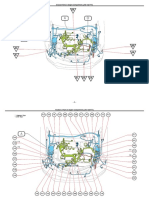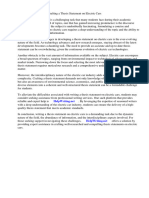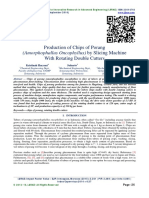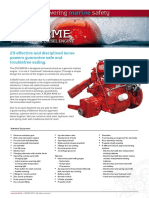Model Car Design: Activity 1: Grades 5-8
Model Car Design: Activity 1: Grades 5-8
Uploaded by
Roubinc KumarCopyright:
Available Formats
Model Car Design: Activity 1: Grades 5-8
Model Car Design: Activity 1: Grades 5-8
Uploaded by
Roubinc KumarOriginal Title
Copyright
Available Formats
Share this document
Did you find this document useful?
Is this content inappropriate?
Copyright:
Available Formats
Model Car Design: Activity 1: Grades 5-8
Model Car Design: Activity 1: Grades 5-8
Uploaded by
Roubinc KumarCopyright:
Available Formats
Scientific American Frontiers . Cars That Think . Teaching Guide . Model Car Design.
PDF | PBS
Activity 1: Grades 5-8
Model Car Design As you observed in this segment of Scientific American
Frontiers, engineers are continually trying to improve the efficiency and environmental sustainability of automobiles. Radical changes such as a hybrid engine that uses both gasoline and electric fuel help on both fronts. New materials used in both engine design and chassis construction not only improve mileage, but also insure a safer ride.
This activity page will offer:
G G G
A hands-on experience in model car design An opportunity to engage critical thinking, analysis and process skills An experience for engineering application, critique and improvement
Model Racers Before a new car makes it to the showroom, various prototypes must be tested and evaluated. In this activity, you'll get a chance to design your own model car. You'll use a variety of materials to construct a vehicle that travels the greatest distance on balloon power. During your trials, you'll use what you observe to update and improve your design and understanding of model car mechanics. Materials
G G G G G G G G
Milk carton Balloon Scissors Wheels from a toy car (or heavy stock paper disks) Paper clips Clay Tape Assortment of construction materials
Scientific American Frontiers . Cars That Think . Teaching Guide . Model Car Design. PDF | PBS
Procedure Basic Prototype
1. Work in teams of two. Use a scissors to cut away the sides of a milk
cartoon to form a basic chassis design that resembles the illustration show here. Punch a hole at the center of the rear end of the chassis. The nozzle of the inflated balloon will be inserted and secured in this opening.
2. Use tape to attach four paper clips to the underside of the chassis. The
extended "arms" of the clips will be used as axles on which to attach wheels. 3. After slipping on the wheels, place a pea-sized lump of clay on the tip of each clip. The clay will prevent the spinning wheels from moving off the paper clip axle.
4. Blow up a balloon and insert its neck through the nozzle hole. Position
your car on a test track and release the balloon nozzle. Observe and analyze its progress along the floor.
Scientific American Frontiers . Cars That Think . Teaching Guide . Model Car Design. PDF | PBS
5. How could you improve the efficiency of your model? What design
changes would improve its performance? With your instructor's approval, update your design. Analyze the new model's performance. Did the changes help? If so, how?
Questions
1. What is the stored source of power for your model car? 2. What are the three most important factors that affect the performance
of your vehicle? 3. What design factors are least applicable for transfer between your scale model and a full-sized vehicle? Explain. Critical Stretch Does a reused balloon have the same energy storage potential as a new balloon? Considering the challenges of balloon reuse, how can you best insure that your testing is not affected by changes in the balloon's stored energy? Solar Extension
1. Suppose your next design challenge is to replace balloon power with
solar power. What new components would you need for your model vehicle? How would they affect the design of your current car? Create a set of blueprints that illustrate your new solar car and share them with classmates. With your teacher's approval and available classroom materials, assemble your new vehicle.
Submersible Connection Like the proposed hybrid engines for cars, the power plants of pre-nuclear submarines included both diesel and electric engines. Use Internet and print resources to learn more about these dual power sources for submersible boats.
Scientific American Frontiers . Cars That Think . Teaching Guide . Model Car Design. PDF | PBS
Compare and contrast their use with the proposed hybrid engines for cars. How were they similar? How were they different? Are hybrid engines used in nuclear submarines? Explain. Transfer of Energy Although the model car got its immediate thrust from the rush of air that raced out of the balloon nozzle, where did this energy first originate? Trace back the steps of energy conversion. Identify each step of the transfer and identify any energy losses associated with that change. Sexy Sales How would you best describe print and broadcast advertisements used to sell new cars? Do they focus more on the mechanics or the appearance of the vehicle? Do they target a specific gender? In the "eyes" of Madison Avenue, what features make an automobile a guys' or gals' car? Do you think that gender-specific ads reinforce stereotypes or do they cater to new markets? In an open classroom forum, discuss and debate these issues. Web Connection National Middle School Science Bowl http://www.scied.science.doe.gov/nmsb/default.htm Science Bowl information that includes solar power and hydrogen fuel car competitions for students. Mousetrap Car http://users.bigpond.net.au/mechtoys/mouse.html Basic overview of the construction of a model car that is powered by a mousetrap engine. Rocket-Science Museum of Minnesota http://www.smm.org/sln/tf/r/rocket/rocket.html A site that illustrates how to use balloon power to move a rocket along a string.
Academic Advisors for this Guide: Suzanne Panico, Science Teacher Mentor, Cambridge Public Schools, Cambridge, MA Anne E. Jones, Science Department, Wayland Middle School, Wayland, MA Gary Pinkall, Middle School Science Teacher, Great Bend Public Schools, Great Bend, KS Cam Bennet Physics/Math Instructor Dauphin Regional Comprehensive Secondary School Dauphin, MB Canada
Scientific American Frontiers . Cars That Think . Teaching Guide . Model Car Design. PDF | PBS
Activity 1: Grades 9-12
........................................................................................................................
Model Car Design
Questions
1. What is the stored source of power for your model car? 2. What are the three most important factors you uncovered that affect the
performance of your vehicle? (Accept all reasonable answers such as larger motor, bigger wheels, etc.) 3. What design factors are least applicable for transfer between your scale model and a full-sized vehicle? Explain. (Accept all reasonable answers such as electric motor, no model load, etc.) (The stored charges contained in the AA cell.)
You might also like
- Resistant Materials Gcse Coursework Example AqaDocument4 pagesResistant Materials Gcse Coursework Example Aqapodajokityk2100% (1)
- Diesel Generator Plant DesignDocument156 pagesDiesel Generator Plant DesignSaviour Udo100% (6)
- 6SL8800TA-Engine 250kVA 50Hz Rev00-1Document3 pages6SL8800TA-Engine 250kVA 50Hz Rev00-1hunais ali ali100% (2)
- Toyota RAV4 2013-2018 Diagrama Eléctrico de MotorDocument469 pagesToyota RAV4 2013-2018 Diagrama Eléctrico de MotorLuis Adolfo Egaña DíazNo ratings yet
- R290LC-7A LowDocument10 pagesR290LC-7A LowAvaa AmgaaNo ratings yet
- Electric Cars Gcse CourseworkDocument4 pagesElectric Cars Gcse Courseworkcprdxeajd100% (2)
- Solar Powered Car ThesisDocument8 pagesSolar Powered Car Thesisdwfp5m7d100% (3)
- Defense PaperDocument8 pagesDefense Paperapi-354357120No ratings yet
- Enviro Science Design BriefDocument6 pagesEnviro Science Design Briefapi-483325574No ratings yet
- Solar Car Literature ReviewDocument6 pagesSolar Car Literature Reviewea3f29j7100% (2)
- Alternative Vehicles. WebquestDocument3 pagesAlternative Vehicles. WebquestmicayeliNo ratings yet
- Gcse Resistant Materials Coursework Mark SchemeDocument7 pagesGcse Resistant Materials Coursework Mark Schemeafjyadcjesbdwl100% (1)
- Gcse Coursework Resistant MaterialsDocument8 pagesGcse Coursework Resistant Materialsvfbgttvcf100% (2)
- Thesis Engine SearchDocument6 pagesThesis Engine Searchkatieboothwilmington100% (2)
- Balloon Car ChallengeDocument8 pagesBalloon Car ChallengeZhiyong HuangNo ratings yet
- Gcse DT Coursework Resistant MaterialsDocument7 pagesGcse DT Coursework Resistant Materialsf5dkcpkf100% (2)
- Balloon Car ReportDocument16 pagesBalloon Car Reportapi-607889548No ratings yet
- Gcse DT Resistant Materials Coursework ExamplesDocument7 pagesGcse DT Resistant Materials Coursework Examplesiuhvgsvcf100% (1)
- The Problem and Its BackgroundDocument8 pagesThe Problem and Its BackgroundearlesparciaNo ratings yet
- Hybrid Cars Term PaperDocument6 pagesHybrid Cars Term Paperbqvlqjugf100% (1)
- Gear Propulsion Solar CarDocument4 pagesGear Propulsion Solar CarLalit TananNo ratings yet
- Rubberband RacersDocument13 pagesRubberband Racersmarandan85No ratings yet
- Resistant Materials Gcse Coursework EvaluationDocument8 pagesResistant Materials Gcse Coursework Evaluationafjwfealtsielb100% (2)
- Two Approaches To Optimize Formula Sae Chassis Design Using Finite Element AnalysisDocument25 pagesTwo Approaches To Optimize Formula Sae Chassis Design Using Finite Element AnalysisIvan Frazzon TeixeiraNo ratings yet
- Resistant Materials Coursework Examples GcseDocument8 pagesResistant Materials Coursework Examples Gcsevyp0bog1w1m3100% (2)
- Resistant Materials Coursework GcseDocument7 pagesResistant Materials Coursework Gcseafjwocqdcjpvgy100% (2)
- 10a.10asolar Challenge Teachers NotesDocument2 pages10a.10asolar Challenge Teachers NotesreshamegaNo ratings yet
- Solar CarDocument16 pagesSolar CarfabihernancastroNo ratings yet
- Flywheel ThesisDocument6 pagesFlywheel Thesisafloattaxmxufr100% (2)
- Collaboration Lesson Plan: Balloon Flexible Straw Rubber Band or TapeDocument4 pagesCollaboration Lesson Plan: Balloon Flexible Straw Rubber Band or Tapeapi-241355685No ratings yet
- Hybrid Engines Teacher GuideDocument3 pagesHybrid Engines Teacher GuidelivialstNo ratings yet
- Automotive Engineering Literature ReviewDocument5 pagesAutomotive Engineering Literature Reviewafdtsdece100% (1)
- English Tech Doc Outline Script 2Document4 pagesEnglish Tech Doc Outline Script 2api-534996794No ratings yet
- Resistant Materials Coursework Examples EdexcelDocument4 pagesResistant Materials Coursework Examples Edexcelbcqv1trr100% (2)
- 2016 FSAE Electric Vehicle Pedal Assembly DesignDocument40 pages2016 FSAE Electric Vehicle Pedal Assembly Designshubham rastogiNo ratings yet
- Project - Spring Powered CarDocument2 pagesProject - Spring Powered CarAhmed Yasser BouslalahNo ratings yet
- Use This One Edited - Capstone Project ProposDocument5 pagesUse This One Edited - Capstone Project Proposapi-647460166No ratings yet
- Air Powered Car ExperimentDocument9 pagesAir Powered Car ExperimentMoch. Choirul Anam,S.SiNo ratings yet
- Thesis Statement Electric CarsDocument6 pagesThesis Statement Electric Carsexuhszief100% (1)
- Thesis On Hybrid VehicleDocument4 pagesThesis On Hybrid Vehiclednnpkqzw100% (2)
- Balloon Car TeacherDocument3 pagesBalloon Car Teachermayamaheshreddy123No ratings yet
- Clarifications and Hints CorectedDocument3 pagesClarifications and Hints CorectedAnonymous LYRHSt8jyNo ratings yet
- A Development of Brake Shoe and Brake Pads Trainer Mockup For Sedan Cars System: Evaluation of Learners Psychomotor Skills Remarks and Performance RatingDocument13 pagesA Development of Brake Shoe and Brake Pads Trainer Mockup For Sedan Cars System: Evaluation of Learners Psychomotor Skills Remarks and Performance RatingRosbert Cabug TulodNo ratings yet
- 2016 FSAE Electric Vehicle Pedal Assembly Design PDFDocument40 pages2016 FSAE Electric Vehicle Pedal Assembly Design PDFCarlos LLivisacaNo ratings yet
- Car Design DissertationDocument7 pagesCar Design DissertationWhatShouldIWriteMyPaperAboutWashington100% (1)
- Capstone Project ProposalDocument4 pagesCapstone Project Proposalapi-659935018No ratings yet
- Cars Model ThesisDocument5 pagesCars Model Thesisamberbutlervirginiabeach100% (2)
- Electric Car Literature ReviewDocument8 pagesElectric Car Literature Reviewafmzethlgpqoyb100% (1)
- Balloon Speed Racer PacketDocument29 pagesBalloon Speed Racer PacketJboy Mnl100% (3)
- Thesis Electric VehicleDocument8 pagesThesis Electric VehicleBuyPapersForCollegeOnlineSingapore100% (2)
- Gcse Resistant Materials Coursework AqaDocument5 pagesGcse Resistant Materials Coursework Aqaafaocsazx100% (2)
- Thesis 1 ResponsiveDocument5 pagesThesis 1 ResponsiveWriteMyPaperCollegeSingapore100% (2)
- Gcse Resistant Materials Coursework Folder ExamplesDocument7 pagesGcse Resistant Materials Coursework Folder Examplesf5dj7xvv100% (1)
- Virtual Motorsports As A Vehicle Dynamics Teaching ToolDocument9 pagesVirtual Motorsports As A Vehicle Dynamics Teaching ToolCaio PaimNo ratings yet
- Gcse Resistant Materials Coursework HelpDocument8 pagesGcse Resistant Materials Coursework Helpidyuurvcf100% (1)
- Science Coursework Electric CarsDocument7 pagesScience Coursework Electric Carsrhpvslnfg100% (2)
- Mousetrap Car Design Challenge 2016Document3 pagesMousetrap Car Design Challenge 2016gernNo ratings yet
- Copy 2 - ReportDocument7 pagesCopy 2 - Reportaplus.consultancyservices.3No ratings yet
- CREEPERDocument8 pagesCREEPERabejuelakrisNo ratings yet
- Capstone Prop 1Document4 pagesCapstone Prop 1api-650282699No ratings yet
- University of West Alabama 5E Lesson Plan Template: Approved January, 2013Document8 pagesUniversity of West Alabama 5E Lesson Plan Template: Approved January, 2013api-468870830No ratings yet
- 91785v00 NN09 StudentCompetitionsDocument4 pages91785v00 NN09 StudentCompetitionsRajeshJosephAbrahamEdasseriathuNo ratings yet
- Electric Cars Thesis StatementDocument5 pagesElectric Cars Thesis Statementcourtneybennettshreveport100% (2)
- New Doc 2018-07-21Document3 pagesNew Doc 2018-07-21mark evonsNo ratings yet
- Becx Verhuur Terberg YT182DT 4x2 E Version 2012-1 LogoDocument2 pagesBecx Verhuur Terberg YT182DT 4x2 E Version 2012-1 LogoAhmed Mostafa Youssef100% (1)
- Catalago Pá Lonking CDM 816Document138 pagesCatalago Pá Lonking CDM 816Diego Valensuela100% (1)
- Introduction of Liu Gong Skeed Steer Loader CLG375Document10 pagesIntroduction of Liu Gong Skeed Steer Loader CLG375mliugong0% (2)
- Volvo Penta Engine Timing Gear Casing and GearsDocument1 pageVolvo Penta Engine Timing Gear Casing and GearsNabeel MohammedNo ratings yet
- VTP CatalogDocument8 pagesVTP CatalogPoothares WongchindaNo ratings yet
- Business Marketing Term 5: PGDM 2017-19: Submitted byDocument8 pagesBusiness Marketing Term 5: PGDM 2017-19: Submitted bySaurabh SinghNo ratings yet
- CFD Simulation of Hydrogen CombustionDocument28 pagesCFD Simulation of Hydrogen CombustionLuis NunesNo ratings yet
- How Car Cooling Systems WorkDocument4 pagesHow Car Cooling Systems WorkyagneshNo ratings yet
- F100-Key Facts (v3-07)Document123 pagesF100-Key Facts (v3-07)Zbor Zbor100% (2)
- Production of Chips of Porang (Amorphophallus Oncophyllus) by Slicing Machine With Rotating Double CuttersDocument7 pagesProduction of Chips of Porang (Amorphophallus Oncophyllus) by Slicing Machine With Rotating Double CuttersIJIRAE- International Journal of Innovative Research in Advanced EngineeringNo ratings yet
- Baoli Introduction1.1Document43 pagesBaoli Introduction1.1truongdangkhoi365No ratings yet
- Second Engineer Motor Exam FinalDocument36 pagesSecond Engineer Motor Exam FinalMariappan NaNo ratings yet
- Roller Chain Drive DesignDocument19 pagesRoller Chain Drive DesignmaiquelernNo ratings yet
- Engine Design Report For Formula Student CompetitonDocument28 pagesEngine Design Report For Formula Student CompetitonNishant NagleNo ratings yet
- Iinterview QuestionDocument5 pagesIinterview QuestionPaul Kenley Alcaraz MagallanoNo ratings yet
- How Jet Engine WorksDocument1 pageHow Jet Engine WorksÉly AmineNo ratings yet
- Electric MotorDocument6 pagesElectric MotorAnfield FaithfulNo ratings yet
- MARELLI Catalogo e Scheda TecnicaDocument61 pagesMARELLI Catalogo e Scheda TecnicaAshfaq Ahmed Khawer bhattiNo ratings yet
- MotoHawk Software PSDocument6 pagesMotoHawk Software PSCABean1No ratings yet
- Unit-1 Force Analysis FullDocument101 pagesUnit-1 Force Analysis FullshanmechanicNo ratings yet
- N63 Engine - WB - BMW v8 Latest 2014 EnginesDocument82 pagesN63 Engine - WB - BMW v8 Latest 2014 EnginesDOMINO66100% (5)
- Overload Protection DevicesDocument29 pagesOverload Protection DevicesLawton AcapulcoNo ratings yet
- Dv29Rme: Bukh Lifeboat Diesel EngineDocument2 pagesDv29Rme: Bukh Lifeboat Diesel EngineDinescu StefanNo ratings yet
- Diesel Generator Sizing - REV0Document8 pagesDiesel Generator Sizing - REV0alinaghib100% (2)
- SL2019-671 Cylinder Lubrication UpdateDocument7 pagesSL2019-671 Cylinder Lubrication UpdateZAHIDUR RAHMANNo ratings yet

























































































